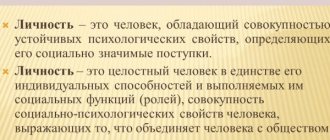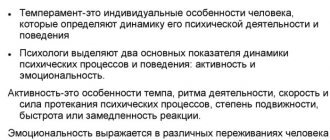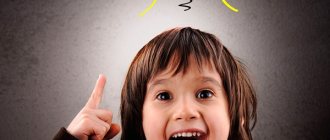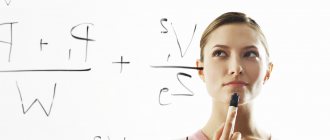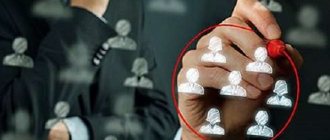Personal abilities are features of the subject’s psyche that affect the success of acquiring skills, knowledge, and abilities. However, the abilities themselves are not limited to the presence of such abilities, signs and skills. In other words, a person’s ability is a unique opportunity for acquiring skills and knowledge. Abilities are manifested only in such activities, the implementation of which is impossible without their presence. They are not found in skills, knowledge and abilities, but in the process of their acquisition and are part of the personality structure. Every person has abilities. They are formed in the process of the subject’s life activity and change together with changes in life’s objective circumstances.
Development of personality abilities
Abilities in the personality structure are its potential. The structural structure of abilities depends on the development of personality. There are two degrees of ability formation: creative and reproductive. At the reproductive stage of development, the individual shows significant ability to master knowledge, activities and implement them according to an explicit model. At the creative stage, an individual is able to create something new and unique. The combination of outstanding abilities that determine the very successful, original and independent performance of various activities is called talent. Genius is the highest level of talent. Geniuses are those who can create something new in society, literature, science, art, etc. The abilities of subjects are inextricably linked with inclinations.
A person’s abilities for mechanical memorization, sensation, emotional excitability, temperament, and psychomotor skills are formed on the basis of inclinations. The possibilities for the development of anatomical and physiological properties of the psyche, which are determined by heredity, are called inclinations. The development of inclinations depends on close interaction with surrounding circumstances, conditions and the environment as a whole.
There are no people who are completely incapable of anything. The main thing is to help the individual find his calling, discover opportunities and develop abilities. Every healthy person has all the necessary general abilities for learning and those abilities that develop during certain activities - special ones. So, the main factor influencing the development of abilities is activity. But in order for abilities to develop, activity in itself is not enough; certain conditions are also needed.
Abilities need to be developed from childhood. In children, engaging in any particular type of activity should evoke positive, constant and strong emotions. Those. such activities should bring joy. Children should feel satisfied with their activities, which will lead to the formation of a desire to continue to engage in further activities without coercion from adults.
Creative expression of activity is important in the development of children’s abilities. So, for example, if a child is passionate about literature, then in order to develop his abilities, it is necessary that he constantly writes essays, works, albeit small ones, with their subsequent analysis. A huge role in the development of the abilities of younger schoolchildren is played by visiting various clubs and sections. A child should not be forced to do things that were interesting to parents in their childhood.
The child’s activities should be organized so that they pursue goals that are slightly beyond his capabilities. If children have already shown abilities for something, then the tasks given to them should gradually be made more difficult. It is imperative to develop in children, along with abilities, self-demandingness, determination, perseverance in the desire to overcome difficulties and criticality in judging their actions and themselves. At the same time, it is necessary to form in children the right attitude towards their abilities, achievements and successes.
The most important thing in developing abilities at an early age is a sincere interest in your baby. It is necessary to pay as much attention to your child as possible and do some work with him.
The decisive criterion for the development of society is the embodiment of the abilities of individuals.
Each subject is individual, and his abilities reflect the individual’s character, passion and inclination towards something. However, the realization of abilities directly depends on desire, regular training and constant improvement in any specific areas. If an individual lacks passion or desire for something, then it is impossible to develop abilities.
CONCLUSIONS FOR CHAPTER 1
Thus, in this section we have established that people with a “lively” temperament (choleric, sanguine) prefer active professions and are not prone to monotonous routine work. On the other hand, it should be emphasized that individuals with a calmer temperament (melancholic, phlegmatic) choose professions that require pedantry, scrupulousness, and special accuracy. We also found out that individuals with different psychotypes tend to choose different professions.
From the above analysis it follows that personal characteristics, in particular, temperament and personality type, undoubtedly have a great influence on the professional orientation of an individual. It seems necessary to note that people of different types of temperament can achieve professional success, since the effectiveness of a person’s activity depends not only on the above characteristics, but also on the attitude to work, interest in work, knowledge and skills, ability to organize work, etc.
Creative abilities of the individual
Many people mistakenly believe that creative abilities include only drawing, writing and music. However, this is absolutely false. Since the development of an individual’s creative abilities is closely interconnected with the individual’s perception of the world as a whole and his sense of himself in it.
The highest function of the psyche, reflecting reality, is creativity. With the help of such abilities, an image of an object that does not exist at that moment or that never existed at all is developed. At an early age, the foundations of creativity are laid in a child, which can manifest themselves in the formation of the ability to conceive and implement it, in the ability to combine their ideas and knowledge, in the sincerity of conveying feelings. The development of children's creative abilities occurs in the process of various activities, for example, games, drawing, modeling, etc.
The individual characteristics of a subject that determine the individual’s success in performing any creative activity are called creative abilities. They represent a combination of many qualities.
Many famous scientific figures in psychology combine creativity with thinking characteristics. Guilford (an American psychologist) believes that creative individuals are characterized by divergent thinking.
People with divergent thinking, when searching for a solution to a problem, do not focus all their efforts on establishing a single correct answer, but look for various solutions in accordance with all possible directions and consider many options. The basis of creative thinking is divergent thinking. Creative thinking is characterized by speed, flexibility, originality and completeness.
A. Luk identifies several types of creative abilities: finding a problem where others do not notice it; collapsing mental activity, while transforming several concepts into one; using the skills that have been acquired in finding solutions from one problem to another; perception of reality as a whole, and not splitting it into parts; ease of finding associations with distant concepts, as well as the ability to provide the necessary information at a certain moment; choose one of the alternative solutions to the problem before checking it; show flexibility of thinking; introduce new information into an existing knowledge system; see things and objects as they really are; highlight what is noticed from what the interpretation offers; creative imagination; easy to generate ideas; refining specific details to optimize and improve the original idea.
Sinelnikov and Kudryavtsev identified two universal creative abilities that developed in the process of historical development of society: realism of imagination and the ability to see the integrity of a picture before its component parts. Imaginative, objective grasping of some significant, general pattern or tendency for the formation of an integral object, before the individual has a clear idea of it and can introduce it into a system of clear categories of logic, is called realism of the imagination.
The creative abilities of an individual are a set of character traits and properties that characterize the level of their compliance with certain requirements of any type of educational and creative activity, which determine the degree of effectiveness of such activity.
Abilities must necessarily find support in natural personality qualities (skills). They are present in the process of constant personal improvement. Creativity alone cannot guarantee creative achievement. To achieve, you need a kind of “engine” that can put mental mechanisms into action. Creative success requires will, desire and motivation. Therefore, eight components of the creative abilities of subjects are distinguished: personality orientation and creative motivational activity; intellectual and logical abilities; intuitive abilities; ideological properties of the psyche, moral qualities that contribute to successful creative and educational activities; aesthetic qualities; communication skills; the individual’s ability to self-manage his educational and creative activities.
1.2. Psychotypes and human abilities for the profession
As you know, the end of the 70s of the 20th century was marked by the emergence of a new system of knowledge, called socionics . The famous psychologist Carl Gustav Jung made a breakthrough in this area by developing the theory of psychological types and establishing a clear relationship between the psychotype and the choice of profession, as well as being able to predict the development of the professional orientation of the psychotype. Let's look at this theory below.
Personality type depending on the vector of its orientation:
- An extrovert is a person who is psychologically oriented to the outside world, active and sociable;
- An introvert is a person who is focused on the inner world, sensitive, reserved and reasonable.
Personality type depending on the predominant way of perceiving life (mental function):
- A thoughtful person is a person who relies primarily on logic and thinking when making decisions. The sphere of feelings is suppressed;
- A feeling person is a person focused on feelings, not logic;
- Senser – a person who perceives the surrounding reality directly through the senses. Intuition is suppressed;
- Intuitive - a person who relies on intuitive, unconscious knowledge rather than direct sensations.
Similar classifications of psychotypes have been proposed by many scientists. Let us dwell on one of them, belonging to the German scientist K. Leonhard.
Types of accentuations according to K. Leonhard
- Hyperthymic. Optimistic, sociable, proactive, active, conflict-ridden, irritable, frivolous.
- Disthymic. Pessimistic, silent, withdrawn, non-conflict, conscientious, fair.
- Cycloid. Changeable type, combining hyperthymia and dysthymia.
- Excitable. Slow, irritable, gloomy, domineering, conscientious, neat, loving animals and children.
- Stuck. Perfectionist, inquisitive, fair, ambitious, touchy, suspicious, jealous.
- Pedantic. Formalist and neat, serious, reliable, non-conflict, passive, boring.
- Anxious. Timid, insecure, defenseless, pessimistic, self-critical, friendly, efficient, sensitive.
- Emotive. Excessively vulnerable, tearful, passive, kind, compassionate, responsive, efficient.
- Demonstrative. Can be both a leader and an opportunist; self-confident, artistic, courteous, captivating, extraordinary, selfish, boastful, lazy.
- Exalted. Extremely sociable, experiencing bright and sincere feelings, amorous, altruistic, compassionate, changeable, prone to panic and exaggerate.
- Extroverted. Sociable and talkative, open, efficient, frivolous, prone to excitement and risk.
- Introverted. Idealist, reserved, philosophizing, non-conflict, principled, restrained, persistent, stubborn. [Electronic resource]: https://headlife.ru/psihotipy-lichnosti/ (Accessed October 13, 2022).
Based on the analysis of these classifications, we can assume that an introvert is able to achieve success, for example, in art, a person with a thinking personality type can achieve success in the scientific field, and an individual with an excitable psychotype can become a successful veterinarian or pediatrician.
Individual abilities of the individual
Individual abilities of a person are general abilities that ensure the success of mastering general knowledge and implementing various types of activities.
Each individual has a different “set” of individual abilities. Their combination is formed throughout life and determines the originality and uniqueness of the individual. Also, the success of any type of activity is ensured by the presence of various combinations of individual abilities that work towards the result of such activity.
In the process of activity, some abilities have the opportunity to be replaced by others, similar in properties and manifestations, but having differences in their origin. The success of similar types of activities can be ensured by different abilities, so the absence of any ability is compensated by another or a set of such abilities. Therefore, the subjectivity of a complex or combination of certain abilities that ensure the successful performance of work is called an individual style of activity.
Now modern psychologists identify such a concept as competence, which means integrative abilities aimed at achieving results. In other words, this is a necessary set of qualities that employers need.
Today, individual abilities of a person are considered in 2 aspects. One is based on the unity of activity and consciousness, which was formulated by Rubinstein. The second considers individual properties as the genesis of natural abilities, which are associated with the inclinations and typological and individual characteristics of the subject. Despite the existing differences in these approaches, they are connected by the fact that individual characteristics are discovered and formed in the real, practical social activity of the individual. Such skills are manifested in the subject’s performance, activity, and self-regulation of mental activity.
Activity is a parameter of individual characteristics; it is based on the speed of prognostic processes and the variability of the speed of mental processes. So, in turn, self-regulation is described by the influence of a combination of three circumstances: sensitivity, a specific rhythm of installation and plasticity.
Golubeva connects various types of activity with the predominance of one of the brain hemispheres. People with a dominant right hemisphere are characterized by high lability and activity of the nervous system, the formation of non-verbal cognitive processes. Such individuals study more successfully, solve assigned tasks well under conditions of lack of time, and prefer intensive forms of training. People with a predominant left hemisphere are characterized by weakness and inertia of the nervous system, they master humanitarian subjects more successfully, they can plan activities more successfully, and they have a more developed self-regulatory voluntary sphere. From this we can conclude that a person’s individual abilities have a relationship with his temperament. In addition to temperament, there is a certain relationship between the abilities and orientation of a person, his character.
Shadrikov believed that ability is a functional feature that manifests itself in the process of interaction and functioning of systems. For example, a knife can cut. It follows that the abilities themselves, as properties of an object, are determined by its structure and the properties of individual elements of the structure. In other words, individual mental ability is a property of the nervous system in which the function of reflecting the objective world is carried out. These include: the ability to perceive, feel, think, etc.
This approach of Shadrikov made it possible to find the correct relationship between abilities and inclinations. Since abilities are some properties of functional systems, therefore, the elements of such systems will be neural circuits and individual neurons that specialize according to their purpose. Those. properties of circuits and individual neurons are special inclinations.
Temperament
Temperament is a type of nervous system, an innate characteristic. This is a set of psychophysical properties of a person that determines the specifics of performing an activity. Rhythm, speed, intensity of reactions - all this depends on temperament. Let's take a closer look at the types of temperaments, and then their properties.
Types of temperament according to Hippocrates
Hippocrates was the first to talk about temperaments. He identified four personality types based on which fluid predominates in a person:
- Holi (bile). These are active and sometimes fussy people. They are characterized by sudden mood swings and sociability, turning into obsession.
- Phlegm (mucus). These are calm, reasonable, slow people.
- Melan holi (black bile). These are pessimists, in a state of decline and characterized by indecision.
- Sangwa (blood). These are active and persistent people who always achieve their goals. Born leaders.
Since then, many studies have been carried out, different classifications of temperaments have appeared, but this typology is still taken as a basis. True, no one talks about the predominance of liquids anymore, and the names have changed a little. The study of temperaments is conducted around the reactions of excitation and inhibition. And the main person in this theory is considered to be I.P. Pavlov.
Temperament in modern psychology
In modern psychology, the following classification of temperaments is used:
- Choleric. Strong, agile, unbalanced type. They say about these people: “Starts with half a kick.” True, the choleric person cools down just as quickly. Moreover, he not only cools down, but forgets the reason for the quarrel, the unpleasant fact itself. Therefore, it is difficult to resolve disagreements with choleric people. Cholerics have leadership qualities, but lack of restraint and emotionality prevent them from achieving a stable result in life.
- Sanguine. Agile, balanced, strong type. The processes of excitation and inhibition occur quickly, but this does not affect the mood as clearly as in a melancholic person. Sanguine people are more into humor. They can be called easy-going. They are distinguished by high adaptive abilities, flexibility, and sociability. These are positive and active people who know how to find an approach to every person and have leadership characteristics. A sanguine person does not tolerate boredom and monotony. It is characterized by high speed and strength in performing activities.
- Phlegmatic person. Strong, balanced, motionless type. The arousal reaction is weak. Phlegmatic people are distinguished by restraint and prudence, which sometimes turn into tediousness. These are the executive and most responsible workers, but living with a phlegmatic person is difficult. He is stingy with emotions, does not know how to empathize, is cautious and passive. Does not like surprises, experiments, novelty. His restraint, resistance to stress and composure are sometimes mistaken by others for indifference. Phlegmatic people do not like changes in activity.
- Melancholic. Weak, unbalanced, mobile type. Like a choleric person, his mood constantly fluctuates, but negative connotations predominate. This is a passive, insecure, vulnerable type. Gets tired quickly and does not adapt well to changes. At the same time, these are the most sincere and empathetic people with a rich and interesting inner world.
Psychologists note that not a single temperament occurs in its pure form. That is, more often a person has 2 or 3 types mixed.
In addition, modern psychology relies on the typology of temperaments by K.G. Cabin boy. He identified two types: extroverts and introverts. The former direct their energy to the outer world, the latter to the inner world. Extroverts have a more acute need for social contacts and group work than introverts. The latter are prone to solitude. This is due to the fact that introverts have a higher sensitivity to external stimuli. Extroverts are more stable, so they need strong emotional influences to be aroused.
Interesting! There are other typologies of temperaments, for example, Galen’s classification, the theory of E. Kretschmer.
Properties
Balance, mobility, strength are properties of temperament. We have already mentioned this, but there are other properties. Let's look at them in more detail:
- sensitivity (sensitivity) – reaction to minimal exposure to a stimulus;
- reactivity - the strength of the emotional reaction to stimuli;
- activity – activity in interpersonal relationships, when performing activities;
- pace of reactions - speed of movements, speech, thinking, performance of activities;
- mobility (plasticity/rigidity) – speed of adaptation to changing conditions.
Let’s imagine portraits of temperaments through a table, where “+” is a high level, and “–” is a low level of some property.
| Sensitivity | Reactivity | Activity | Rate of reactions | Mobility | |
| Choleric | – | + | + | + | + |
| Sanguine | – | + | + | + | + |
| Phlegmatic person | – | – | + | – | – |
| Melancholic | + | – | – | – | – |
In addition, when considering temperaments, it is customary to study concentration. Choleric people have slow concentration (distractable type), sanguine people have fast concentration, phlegmatic people have slow concentration, melancholic people have unstable attention (they get tired quickly, are distracted a lot).
Important! Characteristics of temperament must be taken into account during the learning process, during employment and when building relationships with others. The psychological climate in the family, work team, class, group depends on the compatibility of temperaments.
Social abilities of the individual
Social abilities of an individual are those properties of an individual that are acquired in the process of his development and meet the requirements of significant social activity. They change in the process of education and in accordance with existing social norms.
In the process of social communication, social properties are more expressed in conjunction with the cultural environment. One cannot be excluded from the other. Since it is socio-cultural qualities that play the main role in the formation of the subject as an individual.
In the processes of interpersonal interaction, socio-cultural value is lost, and social abilities cannot be fully demonstrated. The use of social abilities by an individual allows him to enrich his socio-cultural development and improve the culture of communication. Also, their use significantly affects the socialization of the subject.
So, the social abilities of an individual are the individual psychological characteristics of an individual that can allow him to live in society, among people, and are subjective circumstances of successful communicative interaction and relationships with them in any type of activity. They have a complex structure. The basis of such a structure is: communicative, social-moral, social-perceptual properties and ways of their manifestation in society.
Social-perceptual abilities are the individual psychological properties of an individual that arise in the process of his interaction and relationships with other individuals, providing an adequate reflection of their characteristics, behavior, states and relationships. This type of ability also includes emotional and perceptual ones.
Social-perceptual abilities constitute a complex set of communication abilities of an individual. Because it is communication properties that allow subjects to understand and feel another, to establish relationships and contacts, without which effective and complete interaction, communication and teamwork is impossible.
Professional abilities of the individual
The main psychological resource that a person invests in the process of work and activity is professional abilities.
So, a person’s professional abilities are the individual psychological properties of an individual that distinguish him from others and meet the requirements of labor and professional activities, and are also the main condition for the performance of such activities. Such abilities are not limited to specific abilities, knowledge, techniques and skills. They are formed in the subject on the basis of his anatomical and physiological characteristics and inclinations, but in most specialties they are not strictly determined by them. More successful performance of a particular type of activity is often associated not with one specific ability, but with a certain combination of them. That is why professional skills are determined through successful specialized activity and are formed in it, but they also depend on the maturity of the individual and his relationship systems.
Activities and abilities of a person regularly change places throughout an individual’s life, being either a consequence or a cause. In the process of carrying out any type of activity, mental new formations are formed in the personality and abilities, which stimulate the further development of abilities. When the circumstances of an activity become more stringent or when the conditions of the tasks or the tasks themselves change, the inclusion of different systems of abilities in such activities may occur. Probable (potential) abilities are the basis of new types of activities. Since the activity is always adjusted to the level of ability. So, professional abilities are both a result and a condition for successful work activity.
Universal human abilities are those psychological properties that are necessary for the involvement of an individual in any professional and work activity: vitality; ability to work; the ability for self-regulation and activity, which includes prognosis, anticipation of the outcome, goal setting; the ability for empathy, spiritual enrichment, cooperation and communication; the ability to be responsible for the social outcome of work and professional ethics; the ability to overcome obstacles, immunity to interference, and withstand unpleasant circumstances and conditions.
Against the background of the above abilities, special ones are also formed: humanitarian, technical, musical, artistic, etc. These are individual psychological characteristics that ensure the success of an individual in performing certain types of activities.
Professional abilities of an individual are formed based on universal human abilities, but later than them. They also rely on special abilities, if they arose simultaneously with professional ones or earlier.
Professional skills, in turn, are divided into general, which are determined by the subject of activity in the profession (technology, people, nature) and special, which are determined by specific working conditions (lack of time, overload).
Also, abilities can be potential and actual. Potential - appear when new tasks arise for the individual, which require new approaches to solution, as well as under the condition of the individual’s support from the outside, which creates an incentive to actualize potential. Relevant – already today they are carried out in a procession of activities.
What are tendencies?
When a person develops an interest in a particular type of activity, and he strives to develop his inclinations in this direction, then this initial orientation of the individual is called an inclination.
In the process of mastering the chosen direction of development, an inclination can develop into an ability. If a person changes his interests in the process of mastering the chosen direction, then other inclinations may appear, which can be further developed to the corresponding abilities or remain without further development.
Personal communication abilities
In the success of an individual, the determining factor is relationships and interaction with surrounding entities. Namely, communication skills. The success of the subject in professional activities and in other areas of life depends on the degree of their development. The development of such abilities in an individual begins almost from birth. The sooner a baby can learn to speak, the easier it will be for him to interact with others. The communicative abilities of subjects are formed individually for each person. The determining factor in the early development of these abilities is parents and relationships with them; later, peers become influencing factors, and even later, colleagues and one’s own role in society.
If in early childhood an individual does not receive the necessary support from parents and other relatives, then he will not be able to acquire the necessary communication skills in the future. Such a child may grow up insecure and withdrawn. Consequently, his communication abilities will be at a low level of development. The way out of this situation can be the development of communication skills in society.
Communication abilities have a certain structure. They include the following abilities: information-communicative, affective-communicative and regulatory-communicative.
The ability to start and maintain a conversation, complete it competently, attract the interest of the interlocutor, and use non-verbal and verbal means for communication are called information and communication abilities.
The ability to perceive the emotional state of a communication partner, respond correctly to such a state, and demonstrate responsiveness and respect for the interlocutor is an affective-communicative ability.
The ability to help the interlocutor in the process of communication and to accept support and help from others, the ability to resolve conflicts using adequate methods is called regulatory-communicative abilities.
Feelings and emotions
Feelings and emotions are reflected in the individual typological characteristics of the individual. Their manifestations depend on the strength or weakness of the nervous system, its mobility or inertia, as well as the level of culture and upbringing of a person.
Moral, intellectual and aesthetic
Moral, intellectual and aesthetic feelings, the degree of their expression are determined by the living conditions of a person and his upbringing.
An individual's moral feelings are manifested if he evaluates someone's action from the standpoint of its morality or immorality. In addition, the presence or absence of a person’s sense of duty, goodwill, and empathy indicates the degree of development of his moral side of personality.
People also differ in the degree to which they develop their intellectual senses. These include emotional experiences that arise at the time of mental activity: cognitive interest, thirst for discovering new knowledge, passion for scientific research.
Intellectual feelings
Aesthetic feelings express a person’s ability to notice and appreciate the beautiful in everyday life. People differ from each other in their ability to be surprised, to be moved, to experience joy and sadness, to enjoy the contemplation of nature or to empathize with a literary hero.
